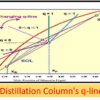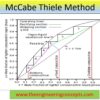Introduction
In order to calculate whether the flow is laminar / turbulent in case of fully developed flow through a non circular pipe or duct it is very complicated. Since in case of non circular duct/pipe the cross section is not uniform throughout. So it is cumbersome to calculate the Reynolds Number through which one can categorized whether the flow is laminar or turbulent.
So for calculating Reynolds Number; Hydraulic diameter – dh –term is introduced as a the characteristic length in case of non-circular pipe / duct work and this Hydraulic diameter is also used in pressure drop and fluid flow rate calculations eqations. This article provides the equations required to determine the hydraulic diameter for a range of non-circular geometries.
Definitions
| A | : | Area |
| B | : | Characteristic Length |
| C | : | Characteristic Length |
| D | : | Characteristic Diameter |
| : | Hydraulic Diameter | |
| : | Wetted Perimeter | |
| Rh | : | Hydraulic Radius |
| : | Characteristic Angle (Radians) |
The hydraulic diameter (Dh) is used for a fluid flowing in a pipe, duct or other conduit of any shape. This uses the perimeter and the area of the conduit to provide the diameter of a pipe which has proportions such that conservation of momentum is maintained.

The concept of the hydraulic diameter allows the use of relationships developed for circular pipes with non-circular conduits. It works well for turbulent flow where geometry is less important, but should not be used for the laminar flow regime, which is influenced to a much higher degree by conduit geometry.
Calculation OF Hydraulic Diameter
The hydraulic diameter is calculated as 4 times the cross-sectional flow area divided by the wetted perimeter of the conduit/pipe.
where as, Hydraulic Radius is calculated as :
The hydraulic radius () is often used for systems with free surface flows, such as water in open channels, streams or rivers.
Hydraulic Diameter for simple Geometry
This list contains the hydraulic diameter for some simple shapes.
Using the Hydraulic Diameter in Pressure Loss Calculations
The hydraulic diameter may be used to determine the flow regime of a flowing fluid by calculating Reynolds Number in a non circular duct / pipe using the hydraulic diameter. If the fluid is in the turbulent regime it may also be used to calculate the friction factor which is subsequently used to calculate the pressure loss for the system.
For the calculation of pressure loss and Reynolds Number the velocity should be calculated by dividing the volumetric flow by the actual cross sectional area of the flow path, and not by using the hydraulic diameter.
Refrences : Neutrium
Image credit : Slideplayer
FURTHER READING
- Perry’s Chemical Engineers’ Handbook, Eighth Edition
- Chemical Engineering Volume 1, Sixth Edition: Fluid Flow, Heat Transfer and Mass Transfer (Coulson & Richardson’s Chemical Engineering)
























Supperb Post